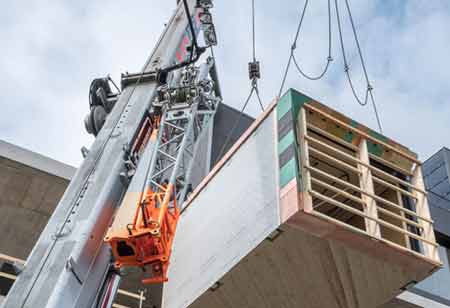Thank you for Subscribing to Construction Business Review Weekly Brief

Prefabrication, Modelling, and the Modular Future of Electrical and Intelligent Transportation Systems in Construction
While prefabrication has been the buzz-word in construction for quite some time now, the implementation and scale of this philosophy have only more recently begun to be realized. With regards to the electrical and Intelligent Transportation Systems (ITS) industries specifically, this area has seen explosive real growth in recent years and the future looks to capitalize even more on this trend.
Where We’ve Been
The early days of the prefabrication trend in outdoor lighting and electrical were more a model of leveraging supplier and vendor capabilities than any real, all-encompassing strategy to reimagine project delivery. Suppliers began to offer lights as a “kit” in which the wire was precut and labelled according to the project documents, saving the installer only minimal time in the field. While vendor/supplier capabilities were constrained by the complexities of varying projects and the skill and manpower necessary to truly highlight the possibilities of prefabrication, contractors themselves have, in recent years, taken the ball and run.
Where We Are
Having the door opened by way of wire “kitting” and prepopulated and fitted boxes for specific applications, contractors began to see and expand on the possibilities that prefabrication could deliver. Within a matter of years, prefab scopes had grown from kitting and assemblies to entire stretches of duct bank and raceway, sometimes miles long. In-house, prefabrication operations grew from a few field workers to entire warehouses and production facilities. The list of benefits grew from minor time savings to far more substantial and tangible operations that are now planned into the job from the beginning, and more recently, factored into estimating. Tunnels and bridges are modelled in three dimensions with accurate scalability, allowing teams to envision and design systems in real-time as they prove their concepts against conflicts with other trades. Lighting and ITS systems are designed, laid out, prebuilt and tested before being transported to the site.
The future of prefabrication is bright and ever- evolving. Project Managers, leaders, and executives should be on a constant lookout for opportunities and new ways to leverage the ability to better control their schedules and improve their Quality programs.
In the transportation construction industry, contractors now look to prefabrication to drag repetitive, laborious, critical tasks to the left of the project CPM. Contractors are working with designers, engineers, and AHJs to make design changes and address means and methods that better cater to leveraging the strengths of prefabrication. Strengths such as schedule management and constructive acceleration, reduction of strenuous physical activity, and the added Quality benefits of build-out in a monitored and controlled environment. Specific to the transportation and outdoor electrical industry, prefabrication is greatly reducing the exposure time for crews in dangerous active roadways and densely populated construction sites.
What Comes Next
The future of prefabrication is bright and ever-evolving. Project Managers, leaders, and executives should be on a constant lookout for opportunities and new ways to leverage the ability to better control their schedules and improve their Quality programs. As with prefabrication opportunities in any industry, this approach requires a heavier team engagement on the front end to save time and effort, as well as to mitigate risk on the back end. Managers need to ensure their negotiated Schedule of Values and AHJs are conducive to stored material invoicing. Chain of custody procedures and modelling/detailing becomes expected expenses at the onset of the project. Every opportunity that can be brought from the back end of a project to the front helps the team maximize project success. Every risk that can be identified early on and mitigated, or eliminated is a win for any project team.
Contractors with advanced prefabrication capabilities are already beginning to reach out to design firms early on in project development cycles to attempt to add their specific capabilities and delivery methods into projects that may still be years out from the execution and delivery phases. It will be interesting to see what innovative, collaborative, and intuitive prefabrication trends develop over the next decade as more companies and AHJs begin to buy into the buzz. There is no longer a question as to whether prefabrication efforts can enhance project success; the most successful contractors in the coming decade will be the ones who maximize this Identified potential.








